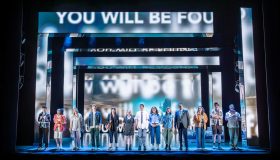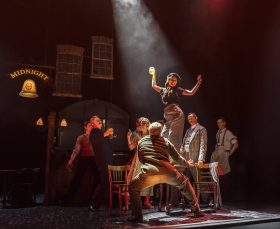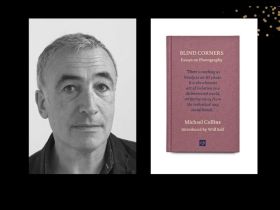Les Rencontres d’Arles, a huge lovesong to the art and social practice of photography set in the ancient and hyper-picturesque city of Arles, France, began with an intense week at the beginning of July. The town’s galleries, public spaces and a number of churches were filled with photo exhibis through September 16. From July 2 through 7, though, the festival offered evening projections and a Lou Reed concert in the Roman theater and a portfolio review along with press conferences and lectures. Seminars on various aspects of photography continued throughout the summer.
Arles is the ideal city for a photography meet-up—and for the same reason that Van Gogh spent so much time here. Through most of the inner town, the ageless pale yellow tufa buildings crowd together along narrow streets. The stone subtly warms the light, filtering it into the shadows, where it flatters everyone.
The aptly named Rencontres (the explicit reference to photography was removed several years ago) places its emphasis on the quality of the contacts one makes by attending. I found this to be generously true. The sensual richness of the environment and the stimulation of the exhibitions, puts people in a receptive mood: any reasonably sociable person can engage in conversation with important movers and shakers of the European photography world, simply by opening conversations with people one encounters at the shows, at the events, and even in the streets.
For up and coming photographers the portfolio review that first week was critical. For €250 you can show your work to 10 experts, whom you choose out of roster of about 30, listing with their biographies on the Rencontres website. You get 20 minutes with each one. Count on great good will and perhaps some useful advice, and hope one of the curators, gallery owners, or publishers will declare you a discovery. The trick is to pick the right reviewers for your work—a hit-and-miss game, where the bios offer only indirect help. Incidentally, in French your portfolio is called your “book,” which rhymes with spook.
One needs several days just to take in the exhibitions. They were divided into 11 major groupings and 48 separate shows, including eight group shows and the rest devoted to individual photographers. Besides these, numerous local galleries held exhibitions on their own to coincide with the official Rencontres ones. It was almost overwhelming.
The city of Arles lent itself to these exhibitions in several ways. Public spaces, including the town hall and several deconsecrated churches were festooned with photographs, producing some surprising incongruities, such as the huge self-portrait of masked and extesively tattooed Spanish photographer Alberto García-Alix blithely urinating, hung in a side chapel of the Eglise Sainte-Anne. The Espace Van Gogh lent its two stories of long halls to major shows, and an abandoned warehouse district on the edge of town, dubbed Les Ateliers (“the studios”), provided the locus for museum-size spaces: large halls with high ceilings accommodated a variety of presental strategies, amidst decaying walls that provided their own visual richness. It was here that what might be called the heart of the exhibitions unfolded. This is where Rencontres made its statements, plotted out new ground, and provided the space for revealing retro- and pro-spective group exhibitions.
Walking into Les Ateliers, the visitor passes through a roofless warehouse with huge grimacing portraits laminated onto the dilapidated walls, with their pock-marks and exposed brick. The exaggerated expressions of this racial, ethnic, and age spectrum of people virtually shout encouragement at you to raise your spirits and prepare for imaginative leaps.
Reflecting current world eco-demograph, China and India dominated these exhibitions with major multi-part shows. Each had a socially pertinent theme revealing the human actuality behind what we in the West experience as tidal economic forces—in India the inglorious armies of Information Technology workers, and in China the go-go state-blessed capitalism and accumulated financial power. The Indian exhibition, curated by Alain Willaume,featured nine Indian photographers whose work eschews traditional themes of poverty and exoticism, in favor of the details of the daily lives of those who work in the IT industries. These are relatively young, middle-class Indians, who live at levels comparable to those of their Western counterparts.
Among the nine portfolios presented was that of Anay Mann, who documents his life with the only woman he has ever loved, Neetka, from her years as a college girl to her marriage with the photographer and subsequent motherhood. It’s a tender portrait, revealing Neetka’s unglamourous and unmistakably Indian beauty and perhaps slight annoyance at being photographed. Mann seems to want to emphasize middle class normality, as he captures her in the shower, in her underwear, sitting at his bedside as he works on his Macintosh Powerbook and most poignantly, listening to music closed-eyed through headphones while their son nurses at her breast.
Bharat Sikka, on the other hand, chooses to focus on the dislocations of technological advancement. He captures the sterility of landscapes dominated by innovatively structured concrete residences lining the horizon of barren waste spaces, punctuated by distant cattle, and the blankness in the faces of the twenty- and thirty-somethings (all male) waiting for the subway at rush hour. Jeetin Sharma prefers to focus on children in costumes and playing with techno-toys that are now apparently ubiquitous, while 28-year-old Siya Singh photographs herself at odd angles and through evocative, light-spattered blurs. Somewhat stronger is the work of 52-year-old New Dehli photojournalist Pablo Bartholomew, who has dredged up the best of his photographs from the 70s and 80s. Emerging from a left-liberal home into the Indian drug and rock and roll culture of his youth, he presents some of the strongest work of this collection: aimless but beautiful young people who, yes, carry a touch of that exoticism that we in the West find so compelling, but in social context that we entirely share.
These photographers certainly succeed at shrinking the Otherness that set Indian photography apart while exploring the lives of those embedded in a flat-world corporate culture and mass society. None of them, however, approach the power of social commentary of the Western masters of the field, photographers such as Robert Frank, Bill Brandt, Bruce Davidson or William Klein, never mind Cartier-Bresson or Sebastiao Salgado (who admittedly rely on a strong component of exoticism for much of their best work), all of them masters of both social documentary and photographic art. The Indians are telling us something—that they are more like us than we have hitherto acknowledged; and this is an important message. But most of them don’t seem to be plumbing the depths and ironies that contemporary Indian novelists such as Vikram Seth or Salmon Rushdie aim for. The one exception is Raghu Rai (b. 1942), who avows that photography for him is a means of discovering the unknown. He is a master at focusing the impact of a sweeping context on the experience of his particular subject. In Evening Prayer a darkening black and white panorama of the Dehli skyline dramatically surrounds a rooftop cubicle where we espy a woman draped in white kneeling and praying. In A Laborer Takes a Nap in a Busy Market, the white-bearded sleeping man occupies the bottom third of the picture, as in a Chagall dream painting, while a tire market buzzes on behind, with blurry ghost-like figure in the midground, as if the sleeping man dreamed them. The composition is striking, and the photographer skillfully sets it up to make the viewer question whether daily life is really a dream.
In China the social contradictions are both more apparent and more painful, as a minimally regulated and often corruption-ridden capitalist economy explodes, while the government limits freedom of expression and ignores crushing large-scale consequences of its social and economic policies, while above all keeping a grip on power. Artists find themselves in the anomalous position of enjoying new but limited freedoms to express their frustrations, while chafing against an authoritarian—but no longer totalitarian—state. This configuration has released enormous imaginative power backed by moral conviction, and the results are searing. Rencontres draws its representatives of Chinese art from a visionary collective of Beijing-based artists located in the Dashanzi art district, also know as 798. Founded in 2002, in an old Bauhaus-style factory complex, it has become home to some 50 studios, 100 galleries, 100 art-related organizations and a prospering retail contingent—which keeps the landlords happy.
Walking into the show I was immediately struck by a series of staged photographs by Liu Bolin entitled Camouflage. In each image of a degraded industrial environment, Liu has placed one or more human figures whose face, hair, hands and clothing are carefully painted to blend in with the scene, turning them into a new kind of ghost. For example, we see a tumble-down red sheet metal roof that has lost its support from a ruined brick wall, surrounded by debris. On second glance we notice a man standing front and center, carefully painted to blend in with all the random detritus, his face and hat the dull red of the roof, his work uniform the color of the bricks. In another at least 18 young people form a human bier holding up an overpass. In another workers lined up in a room are painted the same blue-above-cream-below motif of the walls. The message is clear: people are used then discarded like so many worn-out bricks, interchangeable objects in the infrastructure.
The most striking group of works in the Chinese exhibit, and that receiving the most press attention, was the boldly staged images of the Gao brothers, Gao Zhen (b. 1956) and Gao Qiang (b. 1962), who have been collaborating since 1985 and getting into political hot water since their initial successes in 1989. Their iconic and unforgettable image, featured in an article in Le Monde, shows 14 naked young men, eyes closed, cramped into a large, efficiently designed, compartmented storage closet, filling the compartments in ones and twos, and holding one lit candle per compartment. Entitled Prayer, it’s an image that succeeds in being both fascinating and discomforting. Prayer, after all, even when done in a group, is a highly individual act, whereas here there is pointedly no space for individuality: all interpersonal barriers, including clothing, have been removed, leaving an uneasy intimacy with or despite which the subjects must exercise their spiritual aspirations. The Gao brothers six-panel Hug! Hug! (2002), depicts their performance piece where, naked, they hugged (male) strangers in a public square for as long as 15 minutes at a time, and managed to get other perfect strangers to hug each other. They present these panels broken up into eight square fragments each, evoking mirror walls. The fragmentary partial repetition of the images both give a sense of passing time and make the suggestion that the hugs are attempts to overcome a personal inner fragmentation.
The keynote of the exhibition seems to be photographer Huang Rui’s (b. 1952) clever pun on the meaning of the sounds Chi-na in Chinese: “demolition here.” What a felicitous find! It’s as if the sounds “a-mer-ica” meant “enrich the richest” in Malay. Huang presents his images of struggling Chinese citizens, destroyed walls, and fragments of dismantled temples in large wall panels divided into six squares each, where images alternate with solid painted colors: on the top three squares appears the English word CHINA and on the bottom three the Chinese characters sounding out the same thing. These panels serve as the title introducing a group of 14 additional Chinese photographers, all of whom take aim at the mushrooming growth of Chinese cities, with its heedless destruction of historical neighborhoods and monuments, and the accompanying displacement and corruption, which the government responds to with impotence or indifference. Without a tradition of human rights, there is nothing to impede this growth or to oppose the human demolition in the halls of power, no legal framework to appeal to for redress, and onoly artists with the courage and imagination to expose these human costs fill the breach.
The Chinese show is summarized by a chilling installation that greets the visitor upon entry: realistic, life-size naked plastic bodies hang tensely from the ceiling in various positions of curled agony.
Part II of Joel’s review will continue on Wednesday.




